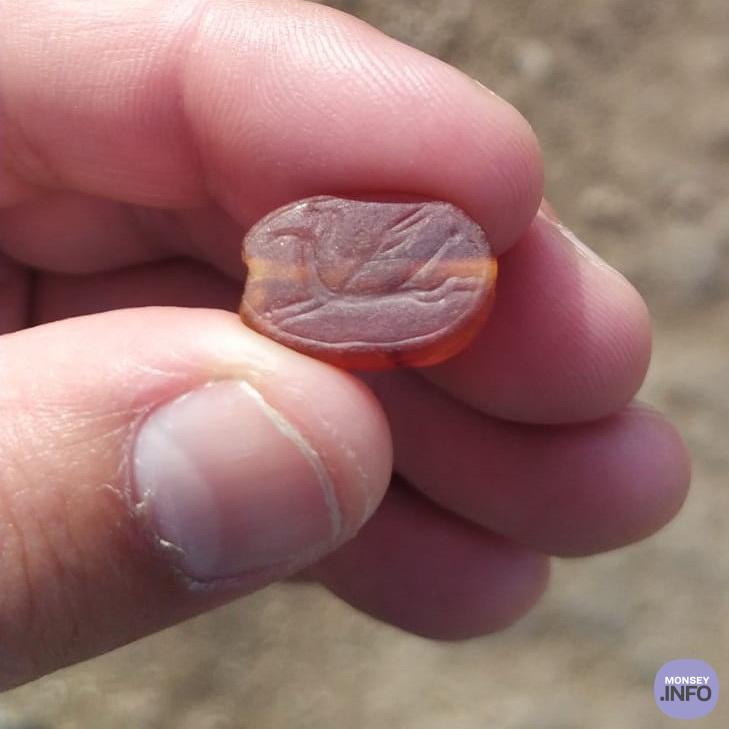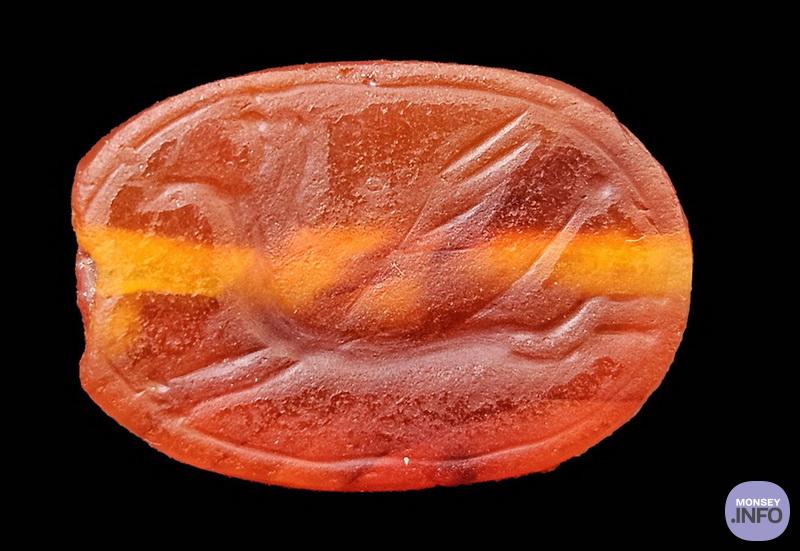
Hiker Discovers First Temple Period Rare Assyrian Amulet-seal in the Tabor Stream Nature Reserve in Lower Galilee
Erez Avrahamov, 45-year-old resident of Peduel, was hiking in the Tabor Stream Nature Reserve in Lower Galilee, when he found an ancient scarab-shaped seal, dating back to the First Temple period. “I had two days off from IDF reserves service, and I decided to take advantage of the sunny days to hike,” says Avrahamov. “While walking, I saw something shiny on the ground, and at first, I thought it was a bead or an orange stone. When I picked it up, I noticed that it was engraved like a scarab or beetle. I called the Israel Antiquities Authority and reported the amazing find.”
According to Nir Distelfeld, Antiquities Robbery Prevention Unit Inspector of the Israel Antiquities Authority, “I received a call from Erez, and I understood that he had found something special. I told him to take a good look at the other side of the scarab—the flat side—and check if it was also engraved. I immediately heard exclamations of excitement on the phone, and he told me that he could see a figure or image.”
According to Professor Emeritus Othmar Keel of the University of Fribourg, Switzerland: “The scarab, made of a semi-precious stone called carnelian, depicts either a mythical griffin creature or a galloping winged horse. Similar scarabs have been dated to the 8th century BCE.” Distelfeld adds that, “the beautiful scarab was found at the foot of Tel Rekhesh, one of the most important tells in Galilee. The site has been identified as ‘Anaharat’, a town within the territory of the tribe of Issachar (Joshua 19:19).”
According to Dr. Itzik Paz, Israel Antiquities Authority archaeologist who excavated at Tel Rekhesh, “This is one of the most important finds from Tel Rekhesh, dated to the Iron Age (7th–6th centuries BCE). At that time, a large fortress stood on the tell which was apparently under Assyrian control, the empire that was responsible for the destruction of the Northern Kingdom of Israel. It is therefore quite possible that the scarab, discovered at the foot of the tell, testifies to the presence of Assyrian (or possibly Babylonian) administration at the site. The griffin motif on the seal is a known artistic motif in ancient Near Eastern art, and it is common on Iron Age seals. If indeed the seal can be dated, it may be possible to link it with the Assyrian presence in the Tel Rekhesh fortress, a discovery of great significance!”
The scarab is a type of seal whose use was widespread throughout the ancient world from the 4th millennium BCE onwards. Scarab seals were shaped like dung beetles, hence their name. The Egyptian name derives from the verb “to become” or “to be created”, as the Egyptians saw the scarab as a symbol of the creator god.
Scarabs were made from a wide variety of stones, including semi-precious stones, such as amethyst and carnelian, but most scarabs were made of steatite, a grayish-white, soft talc stone, which was usually coated with a blue-green glaze. Since the glaze only survived in dry climates, such as Egypt, scarabs found in Israel rarely retain traces of the glaze; in this context, the deep orange color of this scarab is both rare and striking.












